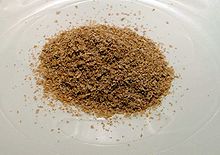Bran

Wheat kernel compartments and macronutrients
Bran, also known as miller's bran, is the hard outer layers of cereal grain. It consists of the combined aleurone and pericarp. Along with germ, it is an integral part of whole grains, and is often produced as a byproduct of milling in the production of refined grains.
Bran is present in cereal grain, including rice, corn (maize), wheat, oats, barley, rye and millet. Bran is not the same as chaff, which is a coarser scaly material surrounding the grain but not forming part of the grain itself.
Contents
1 Composition
2 Rice bran
3 Uses
4 Brewing
5 Stability
6 See also
7 References
Composition
Bran is particularly rich in dietary fiber and essential fatty acids and contains significant quantities of starch, protein, vitamins, and dietary minerals. It is also a source of phytic acid, an antinutrient that prevents nutrient absorption.
The high oil content of bran makes it subject to rancidification, one of the reasons that it is often separated from the grain before storage or further processing. Bran is often heat-treated to increase its longevity.
| Nutrients (%) | Wheat | Rye | Oat | Rice | Barley |
|---|---|---|---|---|---|
| Carbohydrates without starch | 45–50 | 50–70 | 16–34 | 18–23 | 70–80 |
Starch | 13–18 | 12–15 | 18–45 | 18–30 | 8–11 |
Proteins | 15–18 | 8–9 | 13–20 | 15–18 | 11–15 |
Fats | 4–5 | 4–5 | 6–11 | 18–23 | 1–2 |
Rice bran
Rice bran is a byproduct of the rice milling process (the conversion of brown rice to white rice), and it contains various antioxidants that impart beneficial effects on human health.[1] A major rice bran fraction contains 12%-13% oil and highly unsaponifiable components (4.3%).[citation needed] This fraction contains tocotrienols (a form of vitamin E), gamma-oryzanol and beta-sitosterol; all these constituents may contribute to the lowering of the plasma levels of the various parameters of the lipid profile. Rice bran also contains a high level of dietary fibres (beta-glucan, pectin and gum). In addition, it also contains ferulic acid, which is also a component of the structure of nonlignified cell walls. However, some research suggests there are levels of inorganic arsenic present in rice bran. One study found the levels to be 20% higher than in drinking water.[2]
Uses

Rice bran

Wheat bran

Oat bran
Bran is often used to enrich breads (notably muffins) and breakfast cereals, especially for the benefit of those wishing to increase their intake of dietary fiber. Bran may also be used for pickling (nukazuke) as in the tsukemono of Japan. Rice bran in particular finds many uses in Japan, where it is known as nuka (糠; ぬか). Besides using it for pickling, Japanese people also add it to the water when boiling bamboo shoots, and use it for dish washing. In Kitakyushu City, it is called jinda and used for stewing fish, such as sardine.
Rice bran is also stuck to the surface of commercial ice blocks to prevent them from melting. Bran oil may be also extracted for use by itself for industrial purposes (such as in the paint industry), or as a cooking oil, such as rice bran oil.
Wheat bran is useful as feed for poultry and other livestock, as part of a balanced ration with other inputs. Wheatings, a milling byproduct comprising mostly bran with some pieces of endosperm also left over, are included in this category.
Bran was found to be the most successful slug deterrent by BBC's TV programme, Gardeners' World. It is a common substrate and food source used for feeder insects, such as mealworms and waxworms. Wheat bran has also been used for tanning leather since at least the 16th century.[3]
Brewing
George Washington had a recipe for small beer involving bran, hops, and molasses.[4]
Stability
It is common practice to heat-treat bran with the intention of slowing undesirable rancidification. However, a very detailed 2003 study of heat-treatment of oat bran found a complex pattern whereby increasingly intense heat treatment reduced the development of hydrolitic rancidity and bitterness with time, but increased oxidative rancidity. The authors recommended that heat treatment should be sufficient to achieve selective lipase inactivation, but not so much as to render the polar lipids oxidisable upon prolonged storage.[5]
See also
- Alkylresorcinols
- Cereal germ
- Chaff
- Dietary fiber
Phytic acid (IP6)- Rice bran solubles
References
^ Barron, Jon (21 September 2010). "Black Rice Bran, the Next Superfood?". Baseline of Health Foundation. Retrieved 24 August 2012..mw-parser-output cite.citation{font-style:inherit}.mw-parser-output q{quotes:"""""""'""'"}.mw-parser-output code.cs1-code{color:inherit;background:inherit;border:inherit;padding:inherit}.mw-parser-output .cs1-lock-free a{background:url("//upload.wikimedia.org/wikipedia/commons/thumb/6/65/Lock-green.svg/9px-Lock-green.svg.png")no-repeat;background-position:right .1em center}.mw-parser-output .cs1-lock-limited a,.mw-parser-output .cs1-lock-registration a{background:url("//upload.wikimedia.org/wikipedia/commons/thumb/d/d6/Lock-gray-alt-2.svg/9px-Lock-gray-alt-2.svg.png")no-repeat;background-position:right .1em center}.mw-parser-output .cs1-lock-subscription a{background:url("//upload.wikimedia.org/wikipedia/commons/thumb/a/aa/Lock-red-alt-2.svg/9px-Lock-red-alt-2.svg.png")no-repeat;background-position:right .1em center}.mw-parser-output .cs1-subscription,.mw-parser-output .cs1-registration{color:#555}.mw-parser-output .cs1-subscription span,.mw-parser-output .cs1-registration span{border-bottom:1px dotted;cursor:help}.mw-parser-output .cs1-hidden-error{display:none;font-size:100%}.mw-parser-output .cs1-visible-error{font-size:100%}.mw-parser-output .cs1-subscription,.mw-parser-output .cs1-registration,.mw-parser-output .cs1-format{font-size:95%}.mw-parser-output .cs1-kern-left,.mw-parser-output .cs1-kern-wl-left{padding-left:0.2em}.mw-parser-output .cs1-kern-right,.mw-parser-output .cs1-kern-wl-right{padding-right:0.2em}
^ "Inorganic Arsenic in Rice Bran and Its Products Are an Order of Magnitude Higher than in Bulk Grain - Environmental Science & Technology (ACS Publications)". Pubs.acs.org. 21 August 2008. Retrieved 9 February 2010.
^ Rossetti, Gioanventura (1969). the plictho. Massachusetts: The Massachusetts Institute of Technology. pp. 159–160. ISBN 0262180308.
^ George Washington (1757), "To make Small Beer", George Washington Papers. New York Public Library Archive.
^ Lehtinen, Pekka; Kiiliäinen, Katja; Lehtomäki, Ilkka; Laakso, Simo (2003). "Effect of Heat Treatment on Lipid Stability in Processed Oats". Journal of Cereal Science. 37 (2): 215–221. doi:10.1006/jcrs.2002.0496. ISSN 0733-5210. See figure 1 in particular

